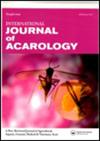脚底锋利的爪子——甲螨(Acari, Chelicerata,不包括Astigmata)跗骨附着装置的多样性综述
IF 1
3区 农林科学
Q3 ENTOMOLOGY
引用次数: 2
摘要
大多数动物的腿上都有爪子,主要用于附着在物体上。最近对爪子形状和功能的研究表明,爪子不仅仅是简单的附着装置,而是高度专业化的形态特征,承载着生活方式、生态和进化的信息。在这方面,关于爪子的知识极其匮乏,特别是在高度多样化的群体中,例如甲脚螨,在世界各地的任何环境中都有超过11000种已命名的物种。本文综述了有关这一节肢动物大类群的爪和相关方面的所有资料。在甲螨中存在着各种各样的足爪形态,这种多样性并不遵循严格的系统发育或系统模式。显然,生活方式和生态在爪子形态的形成中起着重要作用。潮间带甲螨的主要特征是有一个大的跗骨爪,以抵御潮汐洪水,类似的趋势可以在陆生湖滨物种中发现,其中单趾物种占优势。此外,淡水鳞螨通常具有鳞状和倒刺的远端跗骨刚毛,这些刚毛与爪子配合,帮助螨虫粘附在水生植物上。树栖螨虫的爪子上通常有粘胶垫“pulvilli”,使它们能够在光滑的植物表面行走。吸垫也被发现在一些螨虫表现出蜥状生活方式和螨虫能够执行突然逃避跳跃。在大多数情况下,棘甲螨的爪子没有表现出明显的适应性,但某些群体配备了高度修饰的爪子,使它们能够附着在宿主的特定结构上。最后,这篇综述给出了所有爪形态存在于每个较大的系统发育的甲螨组的概述。本文章由计算机程序翻译,如有差异,请以英文原文为准。
Sharp claws beneath our feet – the diversity of tarsal attachment devices of oribatid mites (Acari, Chelicerata, excluding Astigmata) – a review
ABSTRACT The majority of animals possess claws on their legs and they are mainly used for keeping attached to the substrate. Recent studies on claw shapes and function suggest that claws are not just simple attachment devices but highly specialized morphological traits bearing information about lifestyle, ecology and evolution. In that respect, knowledge about claws is extremely scarce, especially in highly diverse groups, as for example the oribatid mites, with more than 11000 named species occurring in every environment all over the world. This review summarizes all information about claws and relevant aspects for this large group of arthropods. There is a huge variety of ambulacral claw morphologies present in oribatid mites and this diversity does not follow a strict phylogenetic or systematic pattern. Lifestyle and ecology apparently play an important role in shaping claw morphologies. Intertidal oribatid mites are mostly characterized by having single large tarsal claws to withstand tidal flooding, a similar tendency can be found in terrestrial limnic species where monodactylous species prevail. Additionally, fresh-water Oribatida often show scaliform and barbed distal tarsal setae which cooperate with the claws helping the mites to stick to water plants. Claws of arboreal mites are often equipped with adhesive pads “pulvilli” allowing them to walk on smooth plant surfaces. Suction pads are also found in a few mites showing epilithic lifestyles and in mites being able to perform sudden evasive jumps. Claws of phoretic oribatid mites show in most cases no apparent adaptations but certain groups are equipped with highly modified claws allowing them to attach to specific structures of their hosts. Finally, this review gives an overview of all claw morphologies present in each larger phylogenetic oribatid mite group.
求助全文
通过发布文献求助,成功后即可免费获取论文全文。
去求助
来源期刊
CiteScore
2.20
自引率
9.10%
发文量
60
审稿时长
6-12 weeks
期刊介绍:
The International Journal of Acarology has a global readership and publishes original research and review papers on a wide variety of acarological subjects including:
• mite and tick behavior
• biochemistry
• biology
• control
• ecology
• evolution
• morphology
• physiology
• systematics
• taxonomy (single species descriptions are discouraged unless accompanied by additional new information on ecology, biology, systematics, etc.)
All submitted manuscripts are subject to initial appraisal by the Editor. If the English is not of a quality suitable for reviewers, the manuscript will be returned. If found suitable for further consideration, it will be submitted to peer review by independent, anonymous expert referees. All peer review is single blind.

 求助内容:
求助内容: 应助结果提醒方式:
应助结果提醒方式:


